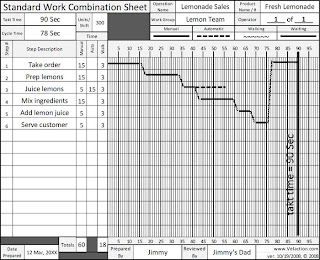Introduction
A Standardized Work Combination Table (SWCT) is also known as a Standardized Work Combination Chart, a Standardized Work Combination Sheet, or some other variant. Regardless of what you call it, it is one of the most critical documents to your Lean success.
The Standardized Work Combination Table combines human movement and machine movement based on Takt Time and is used as a tool to determine the range of work and work sequence for which a team member is responsible.
The key notion for the elimination of waste and the effective combination of
work on the shopfloor is the separation of machine work and human work. When we observe the work in which operators handle machinery, then that work can be classified into machine or human work.
Understanding the separation of human and machine work is the basis for understanding the interface between these two elements. If operators are merely observing the machine working then this is the waste of “Waiting” and should be eliminated.
The Standardized Work Combination Table has many uses:
1. As a training tool, provides a standard that can be clearly communicated to employees during the training process, provides employees with a quick and easy refresher when posted in a work cell. They can glance up and check that they are doing the process correctly. This is especially important as Lean takes hold and employees rotate jobs more frequently.
2. As a quality tool. When a problem is discovered, the first step should be to confirm that the process is being consistently followed. The Standard Work Combination Sheet makes it easy to audit an operation.
3. As a management tool. The Standardized Work Combination Table helps managers: understand their capacity, manage daily operations, keep things running smoothly. Knowing exactly where an employee should be at any point in a takt time lets managers get them help immediately when things go south.
4. As a continuous improvement tool. The Standardized Work Combination Table, to the experienced eye, screams out incidents of waste. When this waste is easily identified, it is much more likely to be eliminated.
Important Points
A Standardized Work Combination Table (SWCT) is also known as a Standardized Work Combination Chart, a Standardized Work Combination Sheet, or some other variant. Regardless of what you call it, it is one of the most critical documents to your Lean success.
The Standardized Work Combination Table combines human movement and machine movement based on Takt Time and is used as a tool to determine the range of work and work sequence for which a team member is responsible.
The key notion for the elimination of waste and the effective combination of
work on the shopfloor is the separation of machine work and human work. When we observe the work in which operators handle machinery, then that work can be classified into machine or human work.
Understanding the separation of human and machine work is the basis for understanding the interface between these two elements. If operators are merely observing the machine working then this is the waste of “Waiting” and should be eliminated.
The Standardized Work Combination Table has many uses:
1. As a training tool, provides a standard that can be clearly communicated to employees during the training process, provides employees with a quick and easy refresher when posted in a work cell. They can glance up and check that they are doing the process correctly. This is especially important as Lean takes hold and employees rotate jobs more frequently.
2. As a quality tool. When a problem is discovered, the first step should be to confirm that the process is being consistently followed. The Standard Work Combination Sheet makes it easy to audit an operation.
3. As a management tool. The Standardized Work Combination Table helps managers: understand their capacity, manage daily operations, keep things running smoothly. Knowing exactly where an employee should be at any point in a takt time lets managers get them help immediately when things go south.
4. As a continuous improvement tool. The Standardized Work Combination Table, to the experienced eye, screams out incidents of waste. When this waste is easily identified, it is much more likely to be eliminated.
Important Points
- Date of making, Owner and revision should be filled
- Q'ty required for each shift
- Takt Time
- Work Element
- Time. Separate human movement and machine movement. Human movement refers to work that cannot be completed without human effort. For example: picking up materials, putting materials onto a machine, operating the controls of a machine, manual slaving etc. Machine movement refers to work or incidental work that equipment, which has been started by human hand, automatically performs operations. For example: Milling, Auto riveting / bolting, Auto inspection (Hole probes).
- Work Sequence

0 comments:
Post a Comment